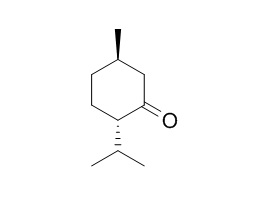Menthone
Menthone has anti-inflammary activity, it can suppress the lipopolysaccharide (LPS)-induced proinflammatory cytokines, interleukin-1beta (IL-1beta) and tumor necrosis factor-alpha (TNF-alpha), as well as nuclear factor kappaB (NF-kappaB) activity induced by LPS and other inflammatory agents. Menthone and menthol enhances the skin permeability by disordering the ordered organization of SC lipids and extracts part of SC lipids.
Inquire / Order:
manager@chemfaces.com
Technical Inquiries:
service@chemfaces.com
Tel:
+86-27-84237783
Fax:
+86-27-84254680
Address:
1 Building, No. 83, CheCheng Rd., Wuhan Economic and Technological Development Zone, Wuhan, Hubei 430056, PRC
Providing storage is as stated on the product vial and the vial is kept tightly sealed, the product can be stored for up to
24 months(2-8C).
Wherever possible, you should prepare and use solutions on the same day. However, if you need to make up stock solutions in advance, we recommend that you store the solution as aliquots in tightly sealed vials at -20C. Generally, these will be useable for up to two weeks. Before use, and prior to opening the vial we recommend that you allow your product to equilibrate to room temperature for at least 1 hour.
Need more advice on solubility, usage and handling? Please email to: service@chemfaces.com
The packaging of the product may have turned upside down during transportation, resulting in the natural compounds adhering to the neck or cap of the vial. take the vial out of its packaging and gently shake to let the compounds fall to the bottom of the vial. for liquid products, centrifuge at 200-500 RPM to gather the liquid at the bottom of the vial. try to avoid loss or contamination during handling.
Int J Mol Sci.2023, 25(1):162.
Adaptive Medicine 2020, 12(1): 4-10
Processes2021, 9(5),831.
Korean J. Agricultural Science2024, 51(3).
Purinergic Signal.2024, doi: 10.1007.
Food Chem. 2020, 320:126530
Plant Growth Regulation2020, 90(2):383-392
American Association for Anatomy2020, doi: 10.1002.
Mol Biol Rep.2024, 51(1):56.
J Pharmaceutical and Biomedical Analysis2022, 114631.
Related and Featured Products
Chin J Physiol. 2008 Jun 30;51(3):160-6.
Inhibition of lipopolysaccharide-induced interleukin-1beta and tumor necrosis factor-alpha production by menthone through nuclear factor-kappaB signaling pathway in HaCat cells.[Pubmed:
18935911]
Menthone, the Chinese old remedy extracted from genus Mentha, has been widely used as a cooling agent, a counterirritant for pain relief, and for the treatment of pruritus. However, its detail mechanisms for interfering inflammatory reaction remain unknown.
METHODS AND RESULTS:
In this study, we found that Menthone can suppress the lipopolysaccharide (LPS)-induced proinflammatory cytokines, interleukin-1beta (IL-1beta) and tumor necrosis factor-alpha (TNF-alpha), as well as nuclear factor kappaB (NF-kappaB) activity induced by LPS and other inflammatory agents, including 12-O-tetradecanoylphorbol-13-acetate, hydrogen peroxide, okadaic acid, and ceramide. Furthermore, our data also demonstrated that the translocation of NF-kappaB activated by LPS into the nucleus was suppressed by Menthone, and I-kappaB and beta-transducin repeat containing protein (beta-TrCP) were both involved in this suppression.
CONCLUSIONS:
To sum up, this study has provided molecular evidence for Menthone effect on the LPS-induced cytokine production, NF-kappaB activation, and the involvement of I-kappaB and beta-TrCP.
Int Immunopharmacol. 2015 Feb;24(2):191-7.
Research on choleretic effect of menthol, menthone, pluegone, isomenthone, and limonene in DanShu capsule.[Pubmed:
25499726]
Danshu capsule (DSC) is a medicinal compound in traditional Chinese medicine (TCM). It is commonly used for the treatment of acute & chronic cholecystitis as well as choleithiasis.
METHODS AND RESULTS:
To study its choleretic effect, healthy rats were randomly divided into DSC high (DSCH, 900mg/kg), medium (DSCM, 450mg/kg), and low (DSCL, 225mg/kg) group, Xiaoyan Lidan tablet (XYLDT, 750mg/kg), and saline group. The bile was collected for 1h after 20-minute stabilization as the base level, and at 1h, 2h, 3h, and 4h after drug administration, respectively. Bile volume, total cholesterol, and total bile acid were measured at each time point. The results revealed that DSC significantly stimulated bile secretion, decreased total cholesterol level and increased total bile acid level. Therefore, it had choleretic effects. To identify the active components contributing to its choleretic effects, five major constituents which are menthol (39.33mg/kg), Menthone (18.02mg/kg), isoMenthone (8.18mg/kg), pluegone (3.31mg/kg), and limonene (4.39mg/kg) were tested on our rat model. The results showed that menthol and limonene could promote bile secretion when compared to DSC treatment (p > 0.05); Menthol, menthol and limonene could significantly decrease total cholesterol level (p<0.05 or p<0.01) as well as increase total bile acid level (p<0.05 or p<0.01); IsoMenthone, as a isomer of Menthone, existed slightly choleretic effects; Pluegone had no obvious role in bile acid efflux.
CONCLUSIONS:
These findings indicated that the choleretic effects of DSC may be attributed mainly to its three major constituents: menthol, Menthone and limonene.
Pharm Dev Technol. 2015 Feb 16:1-10.
Effect of menthone and related compounds on skin permeation of drugs with different lipophilicity and molecular organization of stratum corneum lipids.[Pubmed:
25684238]
The objective of this article was to investigate the enhancing effect of Menthone, menthol and pulegone on the transdermal absorption of drugs with different lipophilicity and probe their mechanisms of action at molecular level.
METHODS AND RESULTS:
Five model drugs, namely osthole, tetramethylpyrazine, ferulic acid, puerarin and geniposide, which were selected based on their lipophilicity denoted by logKo/w, were tested using in vitro permeation studies in which Franz diffusion cells and rat skin were employed. Infrared spectroscopy and molecular dynamic simulation were used to investigate the effect of these enhancers on the stratum corneum (SC) lipids, respectively. Three compounds could effectively promote the transdermal absorption of drugs with different lipophilicity, and the overall promoting capacities were in the following increasing order: pulegone < menthol < Menthone. The penetration enhancement ratio was roughly in parabolic curve relationships with the drug lipophilicity after treatment with menthol or Menthone, while the penetration enhancement effect of pulegone hardly changed with the alteration of the drug lipophilicity.
CONCLUSIONS:
The molecular mechanism studies suggested that Menthone and menthol enhanced the skin permeability by disordering the ordered organization of SC lipids and extracted part of SC lipids, while pulegone appeared to promote drug transport across the skin only by extracting part of SC lipids.



